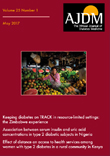Diabetic retinopathy is made by hyperglycemia due diabetes
*Corresponding Author:
Received: 30-Mar-2022, Manuscript No. ajdm-22-63154; Accepted Date: Apr 25, 2022 ; Editor assigned: 01-Apr-2022, Pre QC No. ajdm-22-63154 (PQ); Reviewed: 15-Apr-2022, QC No. ajdm-22-63154; Revised: 22-Apr-2022, Manuscript No. ajdm-22-63154 (R); Published: 29-Apr-2022
Introduction
The retina, which is responsible for receiving visual images, covers the back two-thirds of the eye. The term “retinopathy” refers to a disease of the retina. Looking at the retina through the pupil with an ophthalmoscope shows signs of retinopathy. Diabetic retinopathy can progress to more severe proliferative diabetic retinopathy. Damaged blood vessels thus close, developing new abnormal blood vessels in the retina. These new blood vessels are fragile and can leak into a clear, jelly-like fluid that fills the center of the eye (vitral fluid). The retina may eventually move away from the back of the eye due to the scar tissue formed by the formation of new blood vessels. Pressure can be exerted on the eyeball when new blood vessels block the normal flow of fluid from the eye. Glaucoma occurs when these debris damages the nerves that carry images from the eyes to the brain (the optic nerve).
Description
Over the long haul, an excessive amount of sugar in the blood can harm the retina. The retina identifies light and conveys a message to the cerebrum through the nerve behind the eye (optic nerve). Diabetes harms veins all through the body. Eye harm starts when sugar impedes the little veins that associate with the retina, making liquid break or drain. To compensate for these impeded veins, your eyes develop fresh blood vessels that don’t function admirably. These fresh blood vessels can undoubtedly spill or drain.
With NPDR, little veins spill, making the retina expand. At the point when the macula grows, it’s miles alluded to as macular edema. This is the greatest not unusualplace cause why people with diabetes lose their inventive and insightful. Additionally with NPDR, veins withinside the retina can approach off. This is alluded to as macular ischemia. At the point when that occurs, blood can’t achieve the macula. Now and again little trash alluded to as exudates can shape withinside the retina. These can affect your inventive and perceptive as well.
Retinopathy is any mischief to the retina of the eyes, which could likewise also reason inventive and judicious impairment. Retinopathy every now and again alludes to retinal vascular issue, or damage to the retina because of odd blood flow. Age-related macular degeneration is in fact safeguarded underneath the umbrella time span retinopathy anyway is habitually referenced as a different element. Retinopathy, or retinal vascular problem, might be widely classified into proliferative and non-proliferative sorts. Habitually, retinopathy is a visual indication of fundamental issue as apparent in diabetes or hypertension. Diabetes is the most extreme not unusualplace reason for retinopathy withinside the U.S. as of 2008. Diabetic retinopathy is the primary reason for visual impairment in working-old people. It obligations for roughly 5% of visual impairment worldwide and is novel a worry eye jumble through the World Health Organization [1-4].
Conclusion
Your medical services backer infuses prescription, including against vascular endothelial increment issue pills or corticosteroids, into your eye. These medications help drowsy down infirmity improvement and upgrade inventive and judicious. Your medical services backer utilizes a laser to reduce enlarging to your retina and fresh blood vessel increment. The lasers decline veins or forestall spilling. Your medical services backer can likewise moreover propose this short term eye careful therapy when you have overcast inventive and farsighted due to spilling veins. During a vitrectomy, the consideration doctor makes a little cut in the consideration. The backer can reestablish the veins and remove scar tissue.
Acknowledgement
None
Conflict of Interest
The author has nothing to disclose and also state no conflict of interest in the submission of this manuscript.
REFERENCES
- Yun Z, Wei X, Ping L, et al. The Association between VDR Gene Polymorphisms and Diabetic Retinopathy Susceptibility: A Systematic Review and Meta-Analysis. Biomed Res Int. 2016; 2016:5305282.
[Crossref] [Google Scholar] [PubMed]
- Evans J R, Michelessi M, Virgili G. (2014). Laser photocoagulation for proliferative diabetic retinopathy. Cochrane. Cochrane Database Syst Rev. 2014; 2014(11): CD011234.
[Crossref] [Google Scholar] [PubMed]
- Ning C, Paul M, Yin WT. Diabetic retinopathy. The Lancet. 2010; 376 (9735): 124-136.
[Crossref] [Google Scholar] [PubMed]
- Youseff PN, Sheibani N, Albert DM. Retinal light toxicity. Eye (Lond). 2011; 25(1):1-14.
[Crossref] [Pub Med] [Research Gate]





